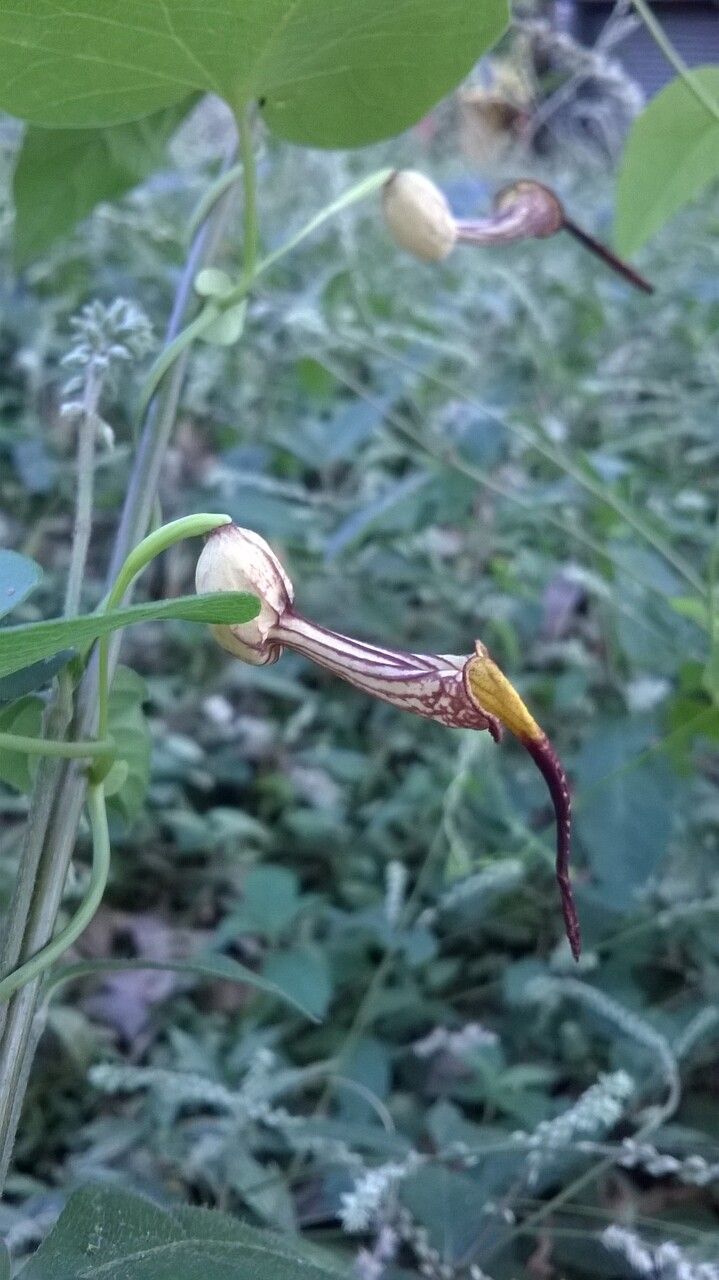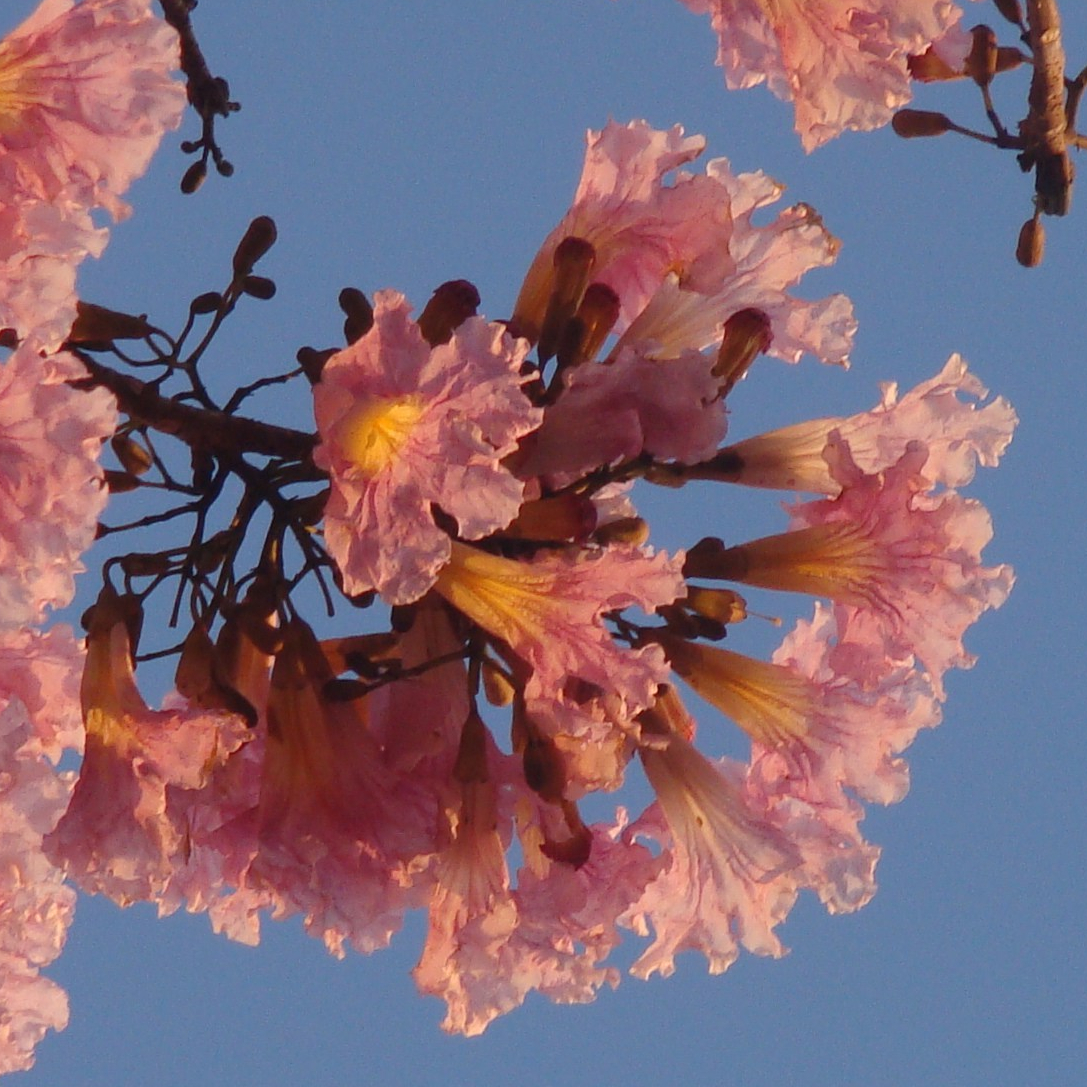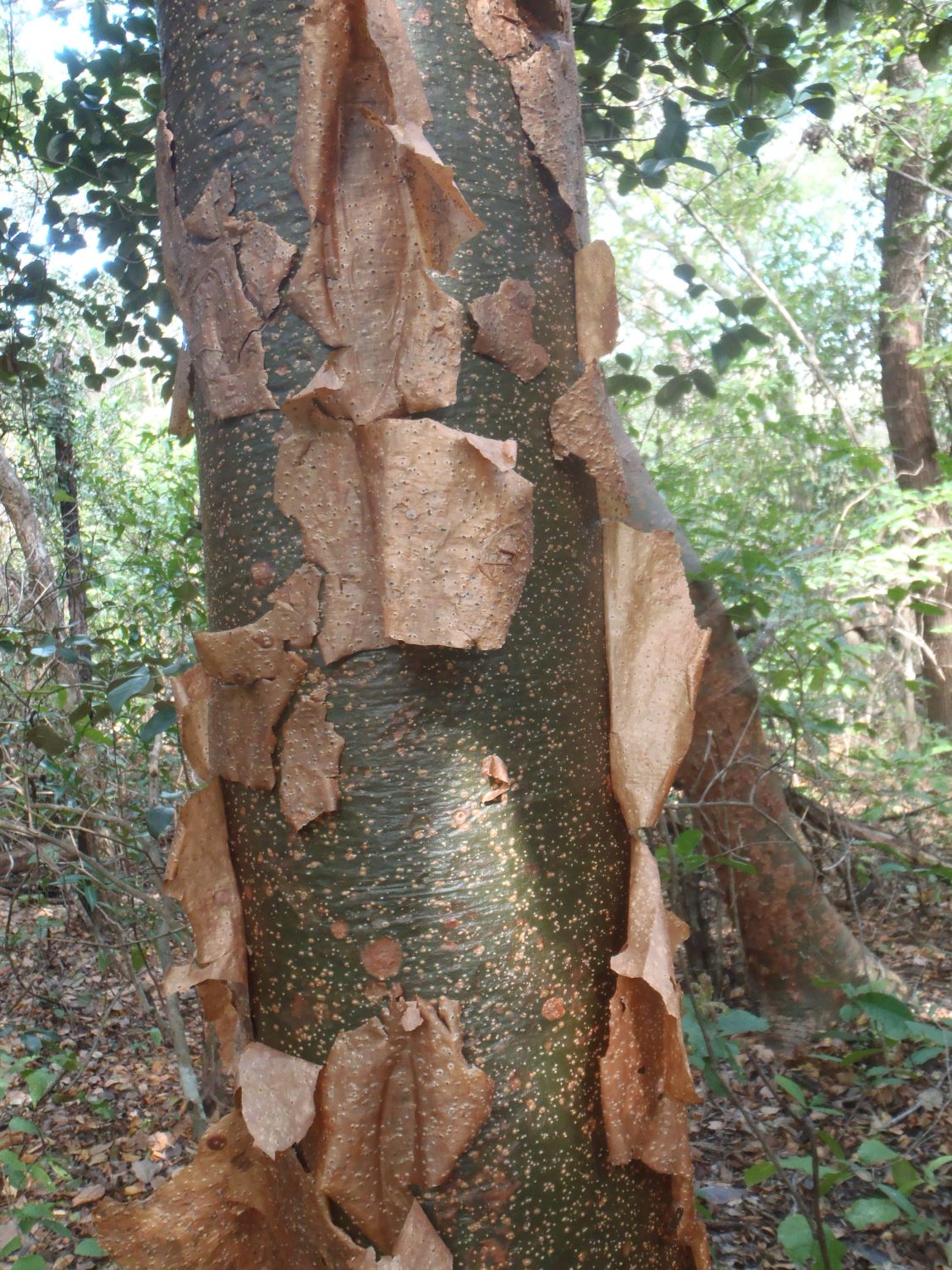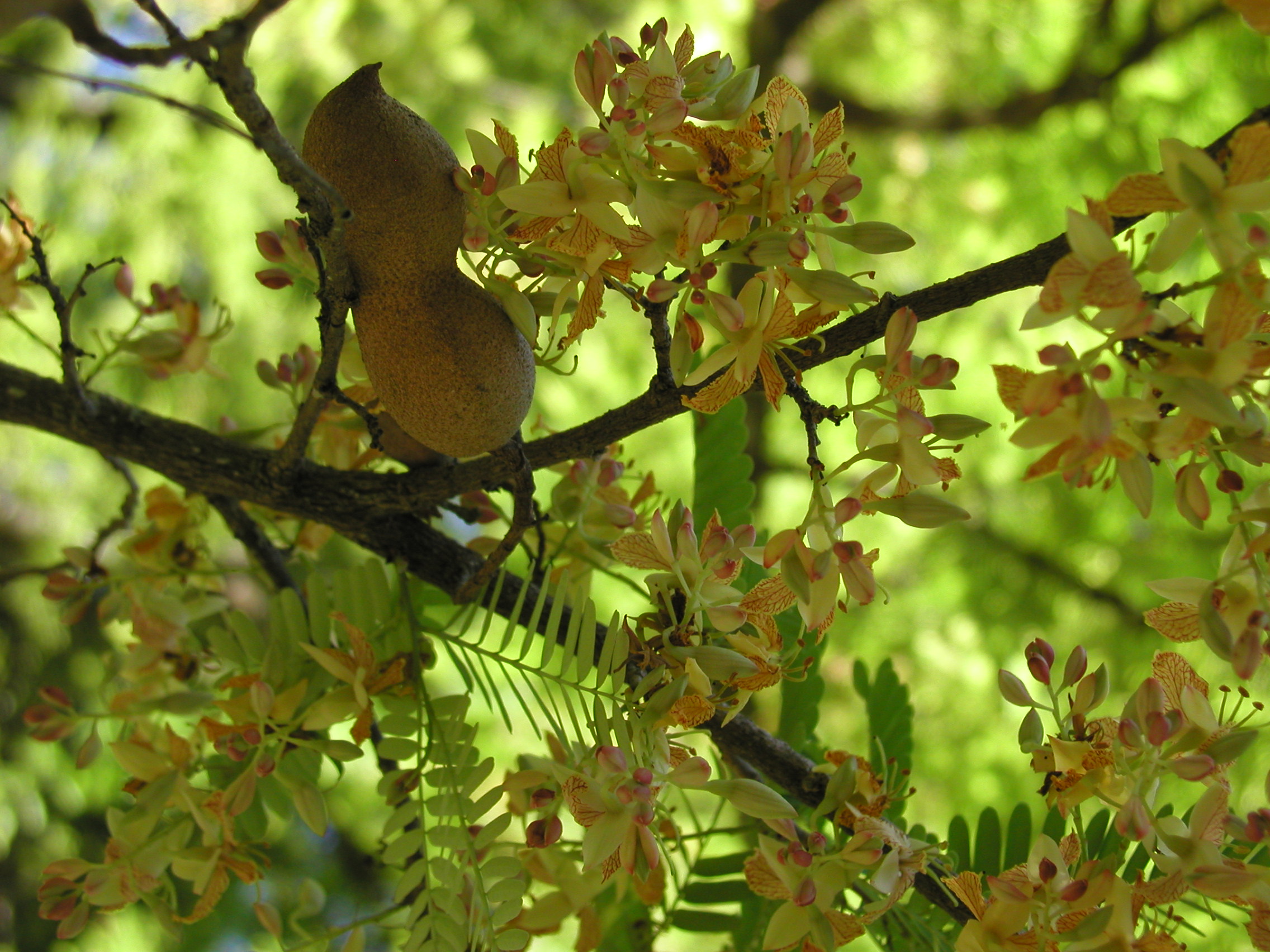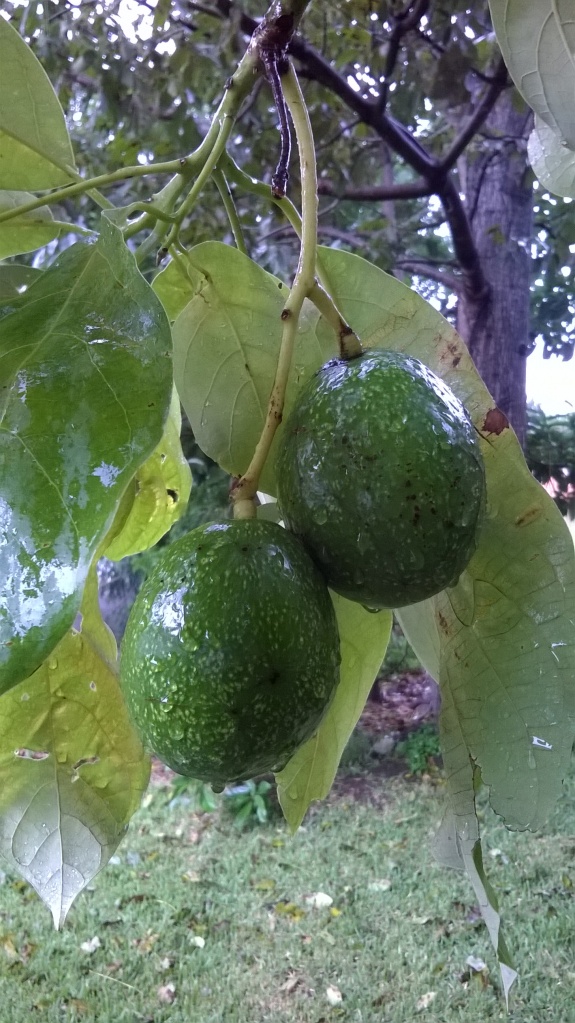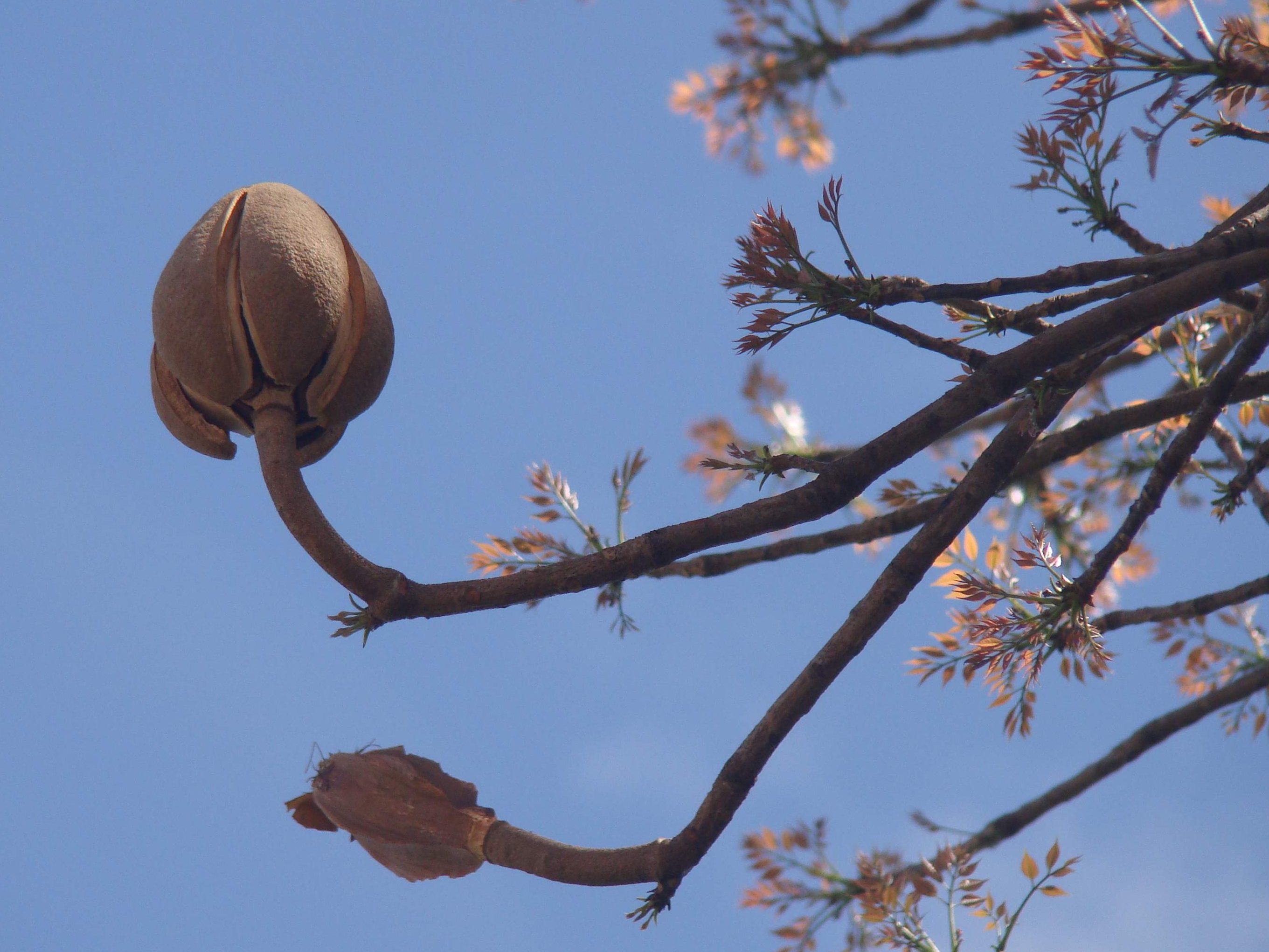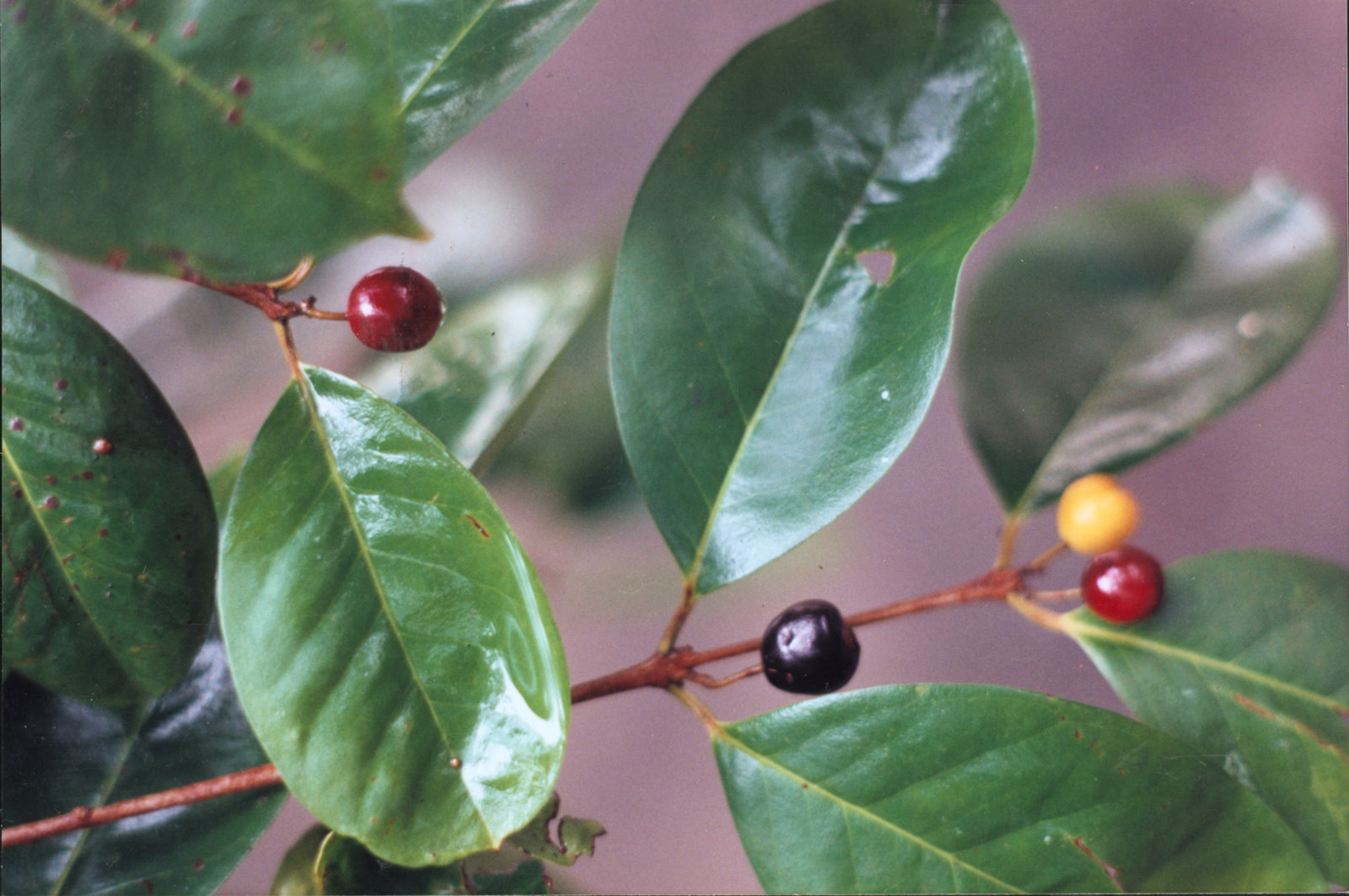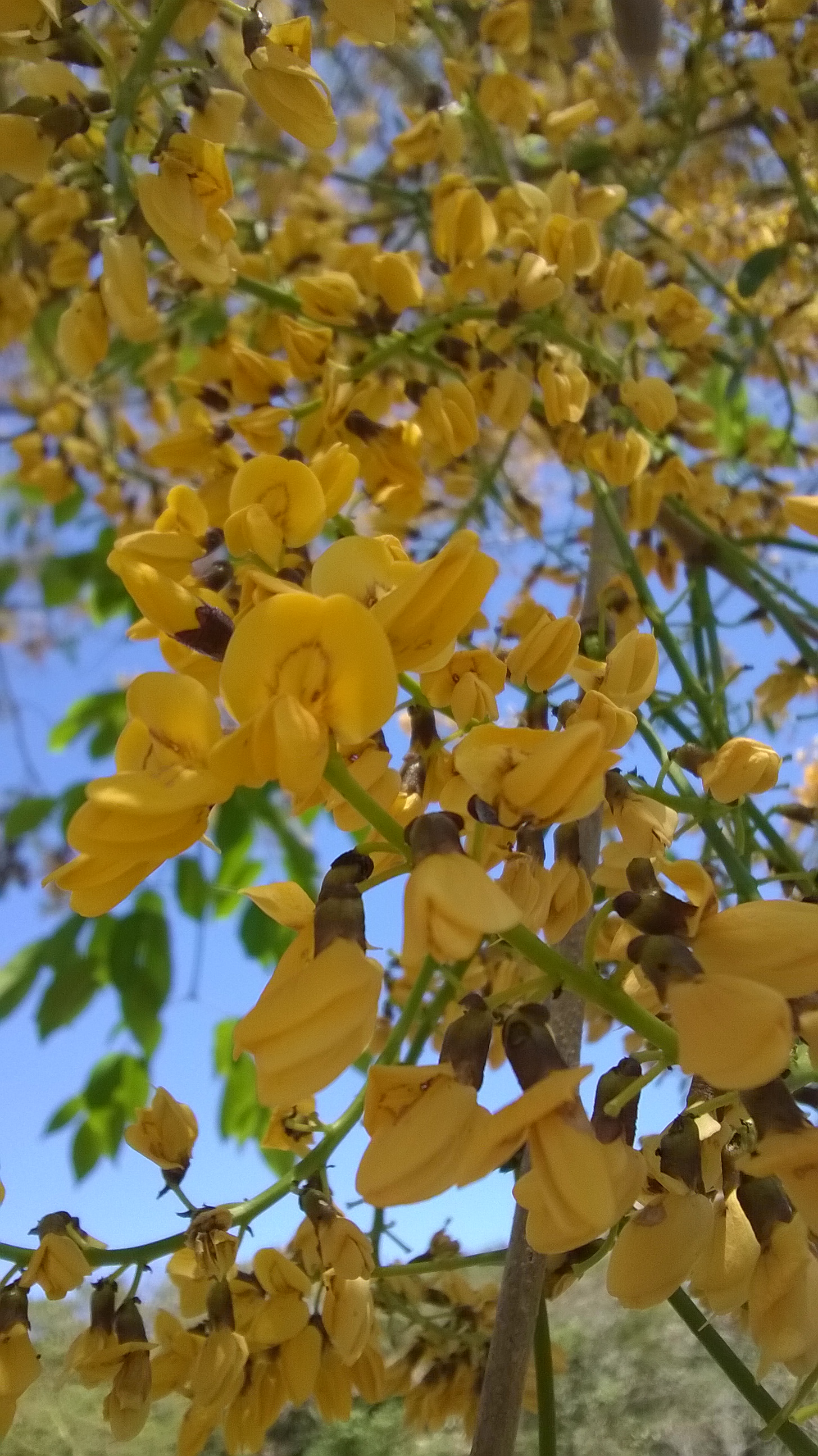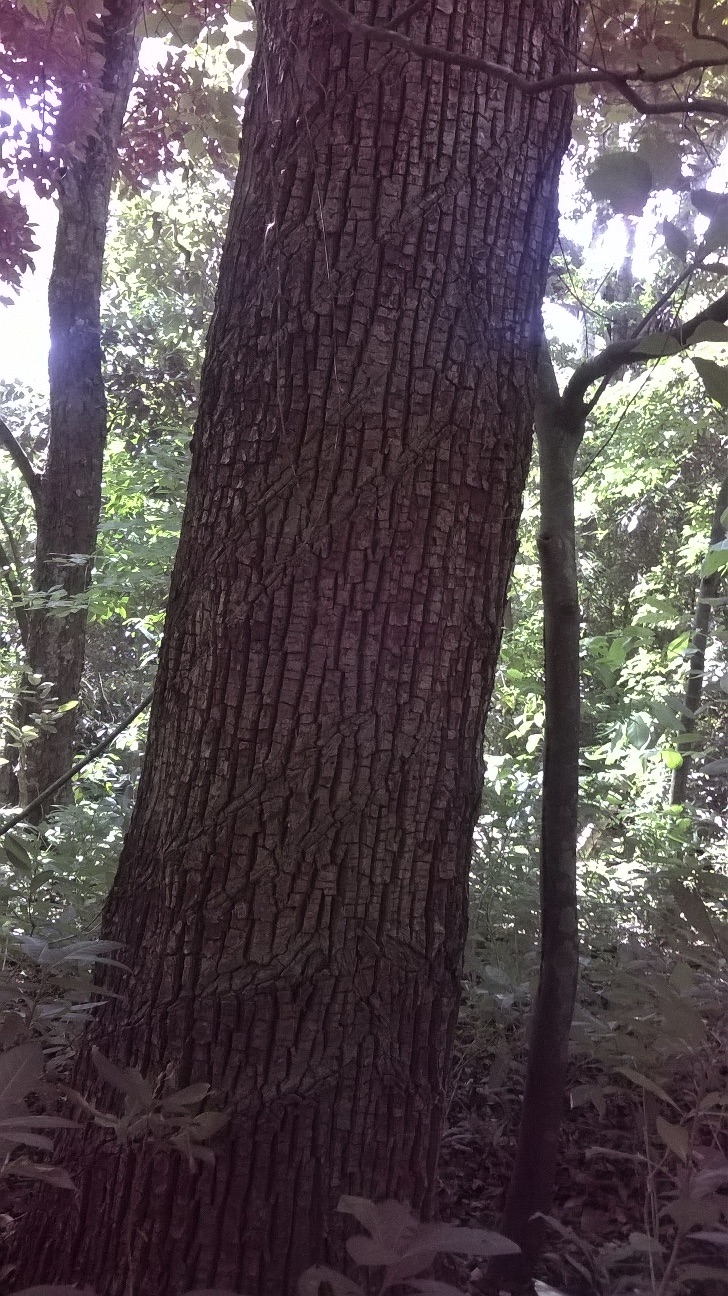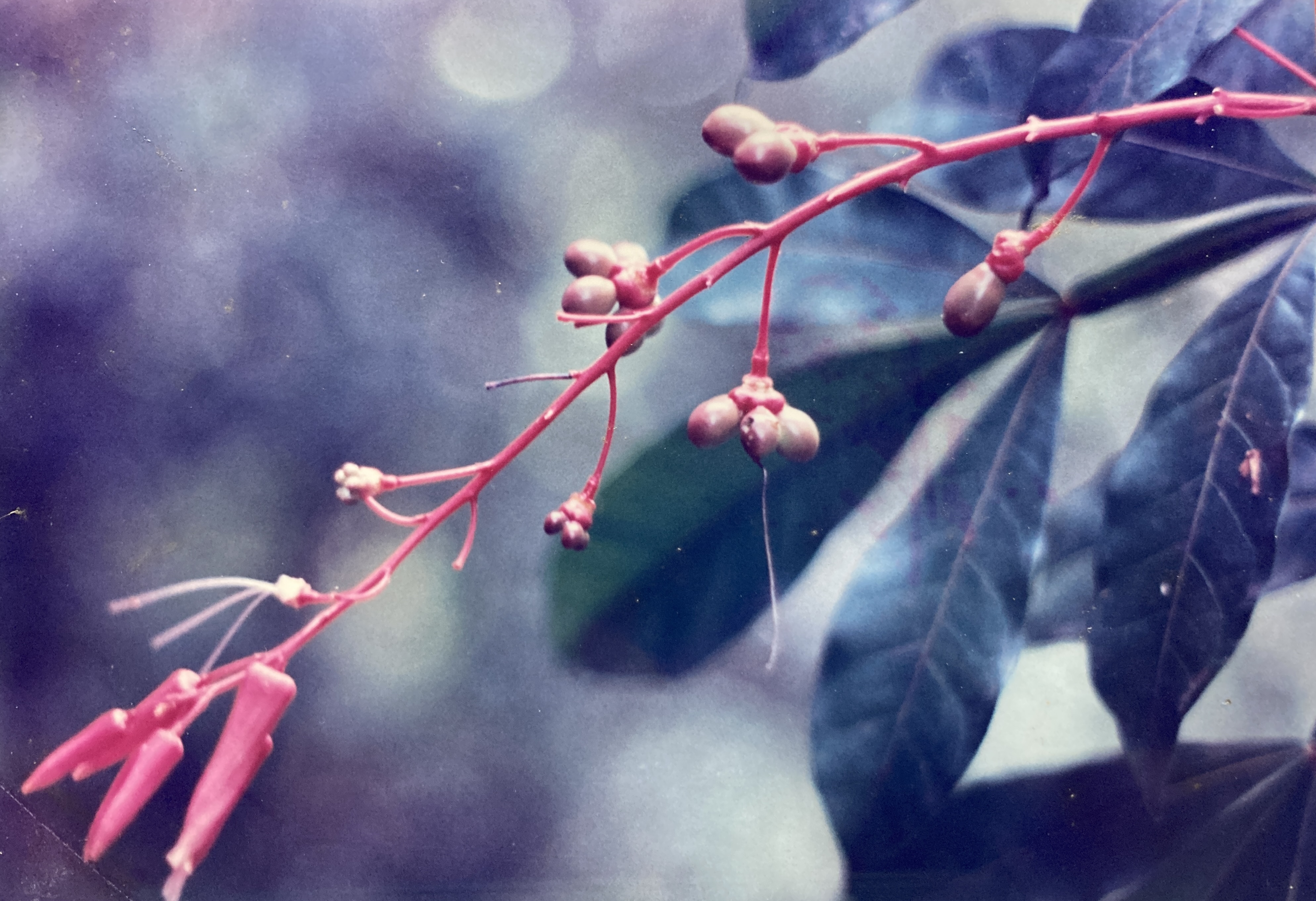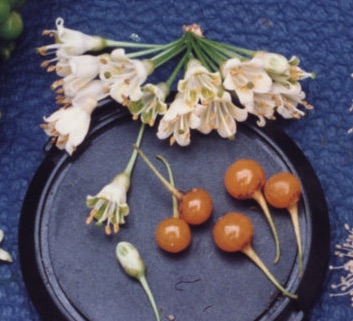Anacardiaceae
The Anacardiaceae is a medium-sized (600 sp.) family of trees, shrubs, and vines that enjoys pantropical and subtropical distribution. One of the most useful diagnostic features shared by many of its members is the thick, clear-yellow, and pungently smelling (sometimes poisonous) resin present in the leaves, stems and fruits. Otherwise, Anacardiaceae leaves are usually pinnately compound and alternate; flowers are regular, bisexual, and possess parts in five’s; and fruits are drupes. Many important species belong to this family. Food producing trees include the cashew (Anacardium occidentale – in which the seed grows below and exterior to the main body of the fruit), the jocote (Spondias purpurea), the pistachio (Pistacia vera), and the mango (Mangifera indica – a tree native to India but now naturalized in much of the world’s tropics). Timber trees include the Espavel (Anacardium excelsum) and the Quebracho (Schinopsis quebracho-colorado). Sumacs (Rhus sp.) – including poison ivy (Rhus radicans) – are among the few temperate representatives of the Anacardiaceae (Kupicha, 1978).
Annonaceae
The Annonaceae is a large (2000 sp.) family of pantropically distributed trees and shrubs. Thought to be one of the most ancient families of flowering plants, it’s flowers bear a number of characteristics usually associated with primitive angiosperms. (These latter features include bisexual, symmetrical blossoms with many parts – all the sepals, stamens, petals, etc. being present; an indefinite number of free petals and sepals; and spirally arranged perianth parts.) Members of the Annonaceae consistently exhibit woody stems laced with canals harboring aromatic oils; glossy leaves arranged in two-tiered rows; fragrant, drooping, regular flowers with many stamens and perianth parts found in multiples of three; and fruits as berries (Mabberley, 1978). Of economic importance are Annonaceae species such as soursop and sweetsop (Annona sp.) whose fruits are used to make refreshing soft drinks, and the extremely odorous, perpetually flowering ylang-ylang tree (Cananga odorata), widely planted in the tropics as an ornamental.
Apocynaceae
A large (1500 sp.), family of pantropical and subtropical distribution, the Apocynaceae includes large and small trees, shrubs, vines and a few herbs. Members share simple leaves that possess – along with other parts of the plant – abundant milky latex; bisexual and fragrant flowers with fused petals (spirally-arranged in the bud) forming a tubular corolla; and fruits that are usually paired and dehiscent. The family is important as a producer of chemicals for medical and industrial use; including cardiac glycosides from Cerbera, Thevetia, Apocynum and other genera; ouabain and cymarin from Strophanthus sp. seeds; and the alkaloids reserpine and rescinnamine from Rauvolfia sp. In addition, some species provide latex for rubber. A few are prized ornamentals, including the widely-planted, Central American frangipani (Plumeria rubra) (Wilkinson, 1978).
Aristolochiaceae
The Aristolochiaceae is a medium sized (625 sp.) family of tropical shrubs and vines. Most members possess simple, alternate and palmately-veined leaves; flowers lacking petals but often bearing colorful calyxes; and fruits as many-seeded capsules. Some species of this family have flowers with interesting shapes, and so are grown as ornamentals (e.g. the Pelican flower, Aristolochia grandiflora) (Moore, 1978). Perhaps not surprisingly, the Aristolochiaceae are closely related to the small family of true, carnivorous, old-world pitcher plants, the Nepenthaceae.
Bignoniaceae
A medium sized family (650 sp.) of pantropically distributed woody lianas and trees, the Bignoniaceae reaches its greatest diversity in South America. Its members are characterized by opposite, compound leaves; showy, bell or funnel shaped flowers with four stamens; and dehiscent fruits containing winged seeds. Of economic importance are a few timber trees (Tabebuia and Catalpa) as well as ornamentals from the Tabebuia, Spathodea, Kigelia, and Jacaranda genera (Richardson, 1978). Spathodea campanulata, the Forest Flame tree, has been widely planted in Costa Rica. It is an African species prized for its abundant, and showy bright orange flowers.
Bombacaceae
The Bombacaceae is an interesting but small (160 sp.) family of trees of pantropical distribution. It reaches its greatest diversity in the rain forests of South America. Anatomical features frequently encountered among members of the group include swollen, water-storing boles (an adaptation for trees in dry habitats); palmately compound, often deciduous foliage; large, nocturnal, bat-pollinated flowers with numerous long stamens and brightly colored perianth parts in five’s; capsular fruits with seeds embedded in cotton; and light, pale colored wood (Humphries, 1978). Famous Bombacaceae species include the immense Ceiba or Kapok tree (Ceiba pentandra) – frequently the sole tree left standing in pastures and the source of kapok (a cottony stuffing material); the Balsa (Ochroma pyramidale) with its light but sturdy wood; and the African Baobab tree (Adansonia digitata).
Boraginaceae
The Boraginaceae is a large family (2000 sp.) of cosmopolitan distribution. Its members include representatives of all growth forms – from herbs and shrubs to vines and trees. Defining characteristics include the presence of fine, rough hairs on stems and leaves; simple, alternate foliage; five-part, regular, bisexual flowers with stamens attached to the lobed corollas; and fruits as drupes. The family is appreciated mainly for its ornamental species, with heliotrope (Heliotropium), Virginia bluebells (Mertensia), and forget-me-nots (Myosotis) constituting well-known examples. Alkanna tinctoria provides a red dye that is used to color wood, wine, medicines, and cosmetics. Borage (Borago officinalis) is a garden herb (Bramwell, 1978). Cordia collococca is one of four Cordia species found in Manuel Antonio National Park (the others being C. alliodora – Laurel, C. bicolor, C. curassavica). All share similar foliage characteristics as well as the hardy, secondary, growth habit.
Burseraceae
The Burseraceae is a medium sized family (500 sp.) of pantropical and subtropical trees and shrubs, with important, large species occurring in Malaya and Africa, as well as in America. Characteristic anatomical features shared by most members of the family include the copious amounts of resin that is found in all plant parts; imparipinnately compound leaves often clustered near branch tips; small, greenish and unisexual flowers; and capsular or drupaceous fruits. Wood is obtained from species of Canarium, Dacryodes, Santiria, and Aucoumea in Malaya and Africa. Boswellia carteri is the Somalian source of frankincense while myrrh derives from Commiphora abyssinica. Bursera has been used as a source of varnish in Mexico. Bursera, Protium, and Tetragastris are the best represented genera of this family in South and Central America (Wilkinson, 1978).
Caesalpiniaceae
Depending upon the reference sited, the Caesalpiniaceae is either considered to be an independent plant family or one of three subfamilies (along with the Mimosaceae and the Papilionaceae) within the Fabaceae (or Leguminosae) family. The Fabaceae, then, is an immense (17,000 sp.), cosmopolitan family of trees, shrubs, herbs and climbers. The most usual – but by no means universal – characteristics of this large group include: alternate, pinnately compound leaves that often “close” (fold up) at night; root swellings, called nodules, containing bacteria (Rhizobium sp.) capable of converting molecular (atmospheric) nitrogen into forms (nitrates, nitrites) more usable by plants; five-part, bisexual flowers in racemes; and fruits that are single-chambered pods enclosing one or many hard-coated seeds.
The Caesalpiniaceae family (or Caesalpinioideae subfamily) is a large group (3000 sp.) of tropical and subtropical trees and shrubs. Its members possess pinnate or bipinnate foliage and irregular flowers with ten or fewer stamens. Well known representatives of the Caesalpiniaceae include the flamboyant or malinche tree (Delonix regia – native to Africa, but planted widely as an ornamental in Costa Rica), with large, red flowers, and massively woody, flat pods; and the tamarind tree (Tamarindus indica), with yellow flowers and fruits that are used to make a local soft drink; and the many species of Cassia (See Cassia grandis) (Chant, 1978).
Capparidaceae
The Capparidaceae is a medium sized family (700 sp.) of pantropical and subtropical distribution, with some species found in temperate regions as well. Including herbs, shrubs, trees, and vines, it is an important component of the vegetation inhabiting Africa’s drier regions. Usual anatomical hallmarks include alternate leaves that are simple or palmately compound; bisexual flowers with sepals, petals, and stamens found in fours or some multiple thereof; and fruits that are capsules or berries. The family has few famous members, though Capers are the flower buds of various Capparis species and Cleome spinosa (spider flower) is grown as a flowering garden plant (Heywood, 1978).
Chrysobalanaceae
The Chrysobalanaceae is a small family (400 sp.) of pantropical and subtropical trees and shrubs. As a group, they have simple, alternate leaves; bisexual flowers with five sepals, two to five petals, and two to 300 stamens; and fruits as drupes. Licania (151 sp.) and Hirtella (89 sp.) are its largest genera, and both are primarily centered in tropical America. Licania supplies water and rot-resistant wood (L. ternatensis) and seed oil (L. rigida and L. arborea). Licania arborea, a dry forest species found in north-western Costa Rica, provides oil for candle and soap making. Also of interest, are the genera Maranthes (12 sp.), of African origin, and the pantropical Parinari (43 sp.). Many species of Parinari are exploited for their fruits in Africa and, along with Maranthes, as timber trees in the Solomon islands (Mabberley, 1978).
Clusiaceae
The Clusiaceae (once called the Guttiferae) is a large family (1000 sp.) of mostly tropical trees, shrubs, and clinging vines. Members share thick, simple, and opposite leaves with closely-spaced, parallel veins; brightly colored (red, yellow, or orange) sap; unisexual or bisexual flowers with parts in fours or fives; and fruits as capsules or drupes.
The most renown members of this family are those with edible fruits – primarily the mangosteen (Garcinia mangostana) and the mammey apple (Mammea americana). Others species are exploited for their ability to provide medicinal drugs (Calophyllum), resins (Garcinia, Clusia), durable wood (Calophyllum, Mesua), dyes (Visma), and cosmetics (Mesua) (Robson, 1978).
Combretaceae
The Combretaceae is a medium-sized family (475 species) of pantropically distributed trees, shrubs, and vines. Its members possess opposite or alternate, entire leaves; small, bisexual flowers on spikes or racemes and with parts arranged in fives; and fruits that are either wind-carried samaras or animal (or water) dispersed fleshy drupes. The Terminalia genus contains some 150 species and is characterized by petal-less flowers and spirally arranged leaves. This genus is important for its timber, with T. oblonga and the West African idigbo (T. ivorensis) and afara (T. superba) particularly worthy of note in this regard (Stace, 1978). The Combretaceae include three genera of mangrove species as well, with Laguncularia racemosa present in Manuel Antonio. This latter species is interesting for its aerial roots – short shoots that emerge from the roots and rise above the mangrove mud to obtain oxygen.
Elaeocarpaceae
The Elaeocarpaceae is a small family (350 sp.) of trees and shrubs. Poorly represented in Central America, it’s members are more typical of southern South America and South-east Asia. They share alternate or opposite leaves with stipules; regular, bisexual flowers with many stamens and perianth parts in four’s or five’s (petals, though, may be lacking); and fruits as capsules or drupes.
Sloanea itself is a large genus, containing about 120 of the family’s species. All produce woody capsules covered by rigid spines. (Morley, 1978). S. terniflora and S. ligulata are two further Sloanea trees found in Costa Rica. The former, present in Guanacaste, has smaller capsules with fine and short, bristle-like spines while the later, common in the forested region around Volcan Arenal, has huge (15 cm) pods with long, wiry quills.
Erythroxylaceae
The Erythroxylaceae is a small family (260 sp.) of shrubs and trees comprising four genera of pantropical distribution but centered in South America’s Andean/Amazon region (Heywood). Important vegetative characteristics include simple, alternate, elliptical leaves with stipules; small, bisexual flowers with a five part perianth and ten stamens; and a fruit as an ovoid drupe. Aside from the narcotic alkaloid obtained from E. coca and E. novaranatense, oils, dyes, tar, and wood have been harvested from different members of this family (Humphries, 1978).
Euphorbiaceae
The Euphorbiaceae is a huge plant family (5000 species in 300 genera) of nearly cosmopolitan distribution but that reaches its greatest concentration in the tropics. Anatomical features include simple, alternate leaves with stipules; five-part, unisexual flowers borne on the same or separate plants; and fruits as schizocarps or drupes. The Euphorbieae, one of eight major tribes that the family is broken into (including Hura, Hippomane, Sapium, and Euphorbia), is further characterized by its abundant, white latex sap. This latex is usually poisonous – as in Hippomane mancinella (see page…) and Hura crepitans (the Sandbox tree: its sap has been placed in streams in order to blind and intoxicate fish). The Euphorbiaceae contain a variety of important species, including those exploited for the production of natural rubber (Hevea brasiliensis), tapioca (Manihot esculenta), castor oil (Ricinus communis), purgatives (Jatropha, Croton tiglium – the later being the most powerful known and so strong that it is no longer used), and the ornamental poinsettia (Euphorbia pulcherrima) (Radcliffe-Smith, 1978).
Flacourtiaceae
A medium sized family of 1250 species, the Flacourtiaceae is made up of trees and shrubs distributed mainly in tropical and subtropical regions. Few botanical characteristics serve to unite this group, but most members do share simple leaves; regular, multi-staminate flowers with petals small or absent; and fruits as berries, drupes, capsules, or samaras. Spines often appear on Flacourtiaceae branches or trunks and flowers may be unisexual, and – if so – the sexes are segregated on different plants. Renown representatives of this family are few – being limited to a few ornamentals, the Burmese Taraktogenos kurzii tree that provides chaulmoogra oil (used in treating leprosy), and the timber tree Gossypiospermum praecox, source of West Indian boxwood (Morley, 1978).
Lauraceae
The Lauraceae is a very large family (2500 sp.) of mostly pan-tropical to sub-tropical (rarely temperate) trees and shrubs. Shared anatomical features include simple, leathery, evergreen leaves containing cavities filled with aromatic oils; regular, inconspicuous, primitive flowers with parts in threes or multiples thereof; and fruits as berries or drupes. Foods, timbers, and oils are the main products obtained from this family, with cinnamon (and camphor) obtained from the bark of Cinnamomum sp.; oil of sassafras from Sassafras sp.; avocados from Persea americana; wood from species of Ocotea (green heart), Litsea, Endiandra, and Beilschmiedia; and bay leaves from Laurus nobilis (Richardson, 1978).
Lecythidaceae
The Lecythidaceae is a small to medium sized family (450 sp.) of pantropically distributed trees, reaching its greatest diversity and abundance in South America. Vegetative characteristics shared by its members include simple, alternate, large leaves; showy, bisexual, bat-pollinated flowers born in terminal spikes and varying in color from yellow to white, pink or red; and large, woody, indehiscent fruits. Bertholletia excelsa, the source of Brazil nuts, is probably the most renown member of the Lecythidaceae. Native to the Amazon basin, this large tree generates heavy, seed-filled pods that can be dangerous when they fall to the ground from high in the canopy. Other seeds, collectively referred to as Sapucaia nuts, are obtained from various species of Lecythis. The cannonball tree (present in Costa Rica), Couroupita guianensis, is known for its large, red flowers and globular, 20 cm fruits – the latter found hanging alongside the bole. One of the few tree species that relies on gravity for seed dispersal, Couroupita‘s pods are reportedly capable of rolling significant distances down slopes. Valuable woods are obtained from Lecythis grandiflora (wadadura wood), Careya (tummy wood), and Bertholletia excelsa (Jones, 1978).
Malvaceae
The Malvaceae (Cotton, Mallows) is a large (1000 sp.), cosmopolitan family of herbs, shrubs, and trees that reaches its greatest diversity in South America. Morphologically, its members share simple, alternate leaves with stellate hairs and stipules; bisexual, regular flowers with five, free, convolute petals, multiple stamens fused to a tube that itself is attached to the corolla, and a pistil with a divided style; fruits as dry capsules often baring hair-covered seeds; and often mucilaginous sap. Hibiscus, with 300 species, is a widely cultivated ornamental genus of shrubs prized for its large, showy flowers. Okra is obtained from H. esculentus. Fiber-producing Malvaceaes include Gossypium sp. (cotton), Abutilon avicennae (China jute), and Urena lobata (aramina) (Jury, 1978).
Melastomataceae
The Melastomataceae is a large (3,000 sp.) family of mostly tropical shrubs and small trees – though vines, herbs, aquatic plants, and epiphytes are also known. It is one of the largest families of plants found in South America and it is especially well represented in the Brazilian Amazon. Members have simple, opposite leaves bearing a distinct pattern of three to nine palmate and parallel main veins, crisscrossed by a finer network of mutually parallel secondary veins; regular flowers with 4-5 free petals and sepals and twice as many stamens; and fruits that are berries or capsules containing many small, wedge-shaped seeds. Economically, select species from this family have been used only sparingly as local sources of timber (Astronia sp., Memecylon sp.), edible fruits (Miconia sp., Medinilla hasseltii, Mouriri sp.), dyes, and ornamentals (Wilkinson, 1978). The hallmark pattern of leaf venation so typical of this family has been interpreted as an adaptation that helps to protect Melastomataceae foliage from the damage done by herbaceous insects. Such a design systematically bounds the thin and tender parts of leaf blades by thick, fibrous veins that are difficult to cut or chew though. Presumably, insects attacking such leaves would make slow progress and perhaps move on to find easier blades to forage.
Meliaceae
The Meliaceae is a small to medium sized family (550 sp.) of pantropically distributed trees and shrubs. Anatomically, most possess alternate, pinnately compound leaves; regular, bisexual or unisexual flowers with parts arranged in threes, fours, or fives; and fruits as capsules, berries, or drupes. By far, the family is most appreciated for its precious hardwoods it provides, including Mahogany (Swietenia sp.), Spanish Cedar (Cedrela mexicana), and Caobilla (Carapa guianenses). In addition, oils for soap making (Trichilia emetica – Uganda), and lighting (Chisocheton macrophyllus – Malaysia) as well as insecticides (Melia sp.) are derived from various Meliaceae plant parts (Mabberley, 1978).
Mimosaceae
Depending upon the botanical source consulted, the Mimosaceae is either given the status of an independent plant family or it is grouped, together with the Caesalpiniaceae and the Papilionaceae, as a subfamily within the Fabaceae (or Leguminosae – see Copaifera aromatica) family. Tropical and subtropical in distribution, the Mimosaceae family (or Mimosoideae subfamily) contains 500-3000 species of trees and shrubs. In addition to those characteristics common to all members of the Fabaceae, anatomical features unique to, or representative of, the Mimosaceae include leaves that are compound and often bipinnate andcomposed of minute leaflets; regular flowers with multiple, filamentous stamens; and fruits as woody or papery pods. Economically important representatives include the Australian black and golden wattle trees (Acacia sp.), providing wattle bark used for tanning, and the Central American Pithecellobium (now Samanea), Enterolobium, and Albizia genera, representing valuable sources of fine hardwoods (Chant, 1978).
Monimiaceae
The Monimiaceae is a small family (450 sp.) of trees and shrubs that reaches its greatest diversity and abundance in the tropics of the southern hemisphere. Anatomically, its members share opposite, leathery leaves often containing aromatic oils; solitary, perigynous flowers; and fruits as achenes. Perfumes and medicines are made from the aromatic oils contained in the leaves and bark of many Monimaiceae species (Doryphora sassafras, Peumus boldus). Useful hardwood is also obtained from some of the trees of this family (Morley, 1978).
Moraceae
The Moraceae is a large family (3000 sp.) of pantropically and subtropically distributed trees and shrubs. Identifying features shared by most members include abundant, white, latex-containing sap; alternate leaves with stipules; unisexual, petal-less flowers situated on hollow receptacles and with four perianth segments; and fleshy, often edible fruits formed from the swollen receptacles. Leading the list of economically important Moraceaes is the large genus of tropical figs (Ficus). Including well over 70 species in Costa Rica alone, the figs provide many varieties of edible fruits as well as sap that has been used in rubber manufacture. The Jamaican breadfruit (Artocarpus), known for its large, starchy, bland, tubercle-covered fruits, has been widely planted in the tropics as a food supplement. Beer manufacture relies on hops (Humulus lupulus) as a source of flavor. The Panama rubber tree (Castilla elastica), native to Costa Rica, was also formerly used in rubber manufacture. Timber has been obtained from osage orange (Maclura), and fustic (Cholorphora tinctoria) – a native, Costa Rican species (Jones, 1978).
Myrcinaceae
The Myrcinaceae is a medium sized family of tropical and sub-tropical trees and shrubs comprising some 1000 sp. The group shares simple and alternate leaves lacking stipules; small, regular flowers with equal numbers (4-6) of sepals, petals, and stamens; and fruits as fleshy drupes. Few members of this family have great economic value, though some of them – including members of the large Ardisia genus – have been used as ornamentals (Bramwell, 1978).
Myristicaceae
The Myristicaceae (nutmeg and mace) is a small (380 sp.), exclusively tropical family of trees. One of the most ancient and primitive families of Angiosperms, its members retain many characteristics (e.g. pyrimidal crown, monopodial trunk) that are considered to be consistent with those of the very first flowering plants to appear on earth some 100 million years ago. More specifically, anatomical features of the Myristicaceae include alternate leaves with aromatic oil glands; horizontal branches arranged about the stem in whorls; red sap; unisexual, small, petalless flowers with three sepals; and fruits as dehiscent berries with seeds enveloped in coarse, brightly colored arils. Nutmeg and mace derive from Myristica fragrans. Myristicaceae seeds, high in starch and fat, are sometimes waxy as well and those of some species (Gymnacranthera farquhariana, Virola surinamensis) have been used to make butter and candles. Finally, the Virola genus as a whole represents an important constituent of the flora located in the Amazon Basin (Chant, 1978).
Myrtaceae
The Myrtaceae is an extremely large family (3000 sp.) of tropical and subtropical trees and shrubs. All – or almost all – have woody stems; oppositely arranged, leathery, and entire leaves; regular, bisexual flowers arranged in cymes and with a four or five part perianth and multiple stamens; and fruits as fleshy berries or drupes. Included within the Myrtaceae is the important and strictly Australian genus Eucalyptus – many of whose fast-growing species have been planted in tropical parks and landscapes. Aromatic oils, obtained from different Eucalypts, have been used in flavorings, expectorants, and antiseptics. Other Myrtaceaes include the sources of spices such as cloves (Syzygium aromaticum) and allspice (Pimenta dioica); the guava fruit (Psidium guajava-West Indies); the ornamental bottlebrush tree (Callistemon sp.-Australia); and the common myrtle (Myrtus commumis-Europe) (Hora, 1978).
Ochnaceae
The Ochnaceae is a medium to large sized family (600 sp.) of pantropically distributed trees, shrubs, and herbs, that reaches its greatest abundance and diversity in Amazonian South America. Anatomically, the group is represented by simple, alternate leaves possessing stipules; regular and bisexual, five-part flowers arranged in racemes or panicles; and fruits as clusters of drupes often born on fleshy floral axes. African oak (Lophira alata, L. lanceolata) is a source of valuable timber while other Ochnaceae species are cultivated in temperate greenhouses as ornamentals (Ochna kibbiensis, Sauvagesia eracta – West Indian iron shrub). The Ochnaceae’s nearest botanical relatives are the Dipterocarpaceae – a large, tropical Asian family that includes many species of emergent proportions. Important timber-producing trees, they dominate the forests of this region (Heathcote, 1978).
Papilionaceae
Depending upon the reference sited, the Papilionaceae is either considered to be an independent plant family or one of three subfamilies (along with the Mimosaceae and the Caesalpiniaceae) within the Fabaceae (or Leguminosae) family. The Papilionaceae, the largest of the three, contains some 10,000 species in 450 genera. Mostly made up of herbaceous plants but including some trees and shrubs, the family boasts cosmopolitan distribution. In addition to the anatomical features common to all legumes (see Copaifera aromatica), the plants of the Papilionaceae possess alternate, usually pinnately compound leaves, and bisexual, butterfly-shaped, irregular flowers with ten stamens. Of vital importance in today’s world, the Papilionaceae include many food and soil-enriching plants. Both clover (Trifolium repens) and lucerne (Medicago sativa) are grown on fallow fields and later turned into the soil in order to enrich it with nitrogen compounds. Garden peas (Pisum sativum), chick peas (Cicer arietinum), kidney beans (Phaseolus vulgaris), lentils (Lens culinaris), and soybeans (Glycine max) are just a few of the many bean species that are responsible for supplying much of the worlds’ protein requirements (Chant, 1978).
Polygonaceae
The Polygonaceae is a very large (750 sp.), mostly north-temperate family of herbs, shrubs, and a few trees. (In fact, Papaturro’s appearance – see description – strongly resembles that of an overgrown shrub and is suggestive of the rather diminutive growth forms typical of this family.) Members of the Polygonaceae share alternate, simple leaves with stipules; small, white, bisexual flowers borne on racemes (or solitarily), and each possessing 3-6 sepals, 6-9 stamens, and no petals; and fruits as triangular nuts. The family includes many species of economically important ornamental plants, as well as some that are known for their edible fruits (West Indian seaside grape – Coccoloba uvifera), leaves (common sorrel – Rumex acetosa), stems (common rhubarb – Rhuem rhaponticum) and seeds (common buckwheat – Fagopyrum esculentum) (Wright, 1978).
Rhamnaceae
The Rhamnaceae is a large (900 sp.), cosmopolitan family of trees and shrubs. Its members usually possess simple, opposite or alternate leaves with stipules; small and inconspicuous, four or five part, regular flowers; and fruits as drupes. The family has economic importance, mainly as a source of dyes and medicinal substances. Krugiodendron cathartica, R. infectoria, and R. chlorophora can be used to generate sap-green, yellow, and indigo-green tints, respectively. A purgative is obtained from the bark of R. purshiana (cascara sagrada, North America), cholera is treated with a chemical obtained from Ventilago oblongiflora (Malaya), and Gouania sp. (Africa) yields a treatment for sores and wounds. Of historical interest are Paliurus spina-christi, used to make Christ’s crown of thorns; and Zizyphus lotus, the flowering lotus (Jones, 1978).
Sapotaceae
A large family (800 sp.) of pantropically distributed trees, the Sapotaceae is one of the largest and most important in the Neotropics. Compared to other plant families, it is an especially closely knit group, with a number of unusual characteristics uniformly shared between its members. Sapotaceae leaves, twigs, inner-bark, and fruits possess large quantities of thick, white, latex sap that becomes evident when these parts are injured or broken (a trait shared with the Moraceae and the Euphorbiaceae). Sapotaceae leaves are simple, alternate and often clustered around the ends of the branches in a whorl-like fashion – with the remainder ofthe branch remaining bare behind them. Pale green or white corolla tubes dominate the flowers, each formed from five fused petals and supporting five attached stamens. Blossoms appear in clusters from leaf axils, usually on the bare portions of the branches behind the leaves, and are sometimes nocturnal and bat pollinated. Fruits are generally large, rounded berries, each possessing a thick, woody husk surrounding a thin layer of milky pulp. The single, large, cylindrical seed has a hard, glossy-brown surface marked on one side by an extremely characteristic, dull, longitudinal scar. Economically, the family has great global importance as a source of hard (often siliceous), durable timber, as many large Sapotaceae trees are found throughout the world’s rain forests. Numerous products have been procured from the latex of various Sapotaceae species, among them Gutta-percha (a rubbery polymer from the Indonesian Palaquinm gutta tree), and chickle (a base for chewing gum, from the Central American Manilkara zapota tree – individuals of this species present in Santa Rosa National Park still bare the diagonal slash scars from the harvest of this material). Edible Sapotaceae fruits include the sapodilla plum (from the Achras zapota tree) and the star apple (from the Chysophyllum cainito tree) (Whitmore, 1978).
Simaroubaceae
The Simaroubaceae is a medium sized family (120 sp.) of tropical and subtropical trees and shrubs. Most members, including the Costa Rican genera of Picramnia, Quassia, Simarouba, and Alvaradoa, have pinnately compound leaves; bitter-tasting wood and bark; and numerous, small flowers. Among the more famous temperate representatives, the “Tree of Heaven” (Ailanthus altissima) is widely grown in northern regions as a (foul smelling) ornamental tree. The Quassia, Picrasma, and Picramnia genera are all considered to have value as medicinal plants (See Quassia amara) (Morley, 1978).
Solenaceae
The Solanaceae is a large (2,000-3,000 sp.), cosmopolitan family of herbaceous plants (though a few shrubs and trees are also represented). Reaching its greatest diversity in Australia and tropical America, the group probably originated on the South American continent. Most of its members share simple, alternate leaves; regular, bisexual, five-part flowers produced in axillary cymes and contained within highly persistent calyxes; and fruits as many-seeded berries. The Solanaceae is credited as being one of the most important plant families serving mankind, for included among its ranks are such nutritionally and economically vital crops as tomatoes (Lycopersicon esculentum), potatoes (Solanum tuberosum), peppers (Capsicum sp.), paprika (Capsicum sp.), and tobacco (Nicotiana tabacum). Other Solanaceae species have been exploited as ornamentals, thanks to their showy flowers (Petunia sp., Datura sp.), colorful fruits (Capsicum sp., Solanum sp.) or shrubby growth habit (Cestrum sp., Lycium sp.). A large number of Solanaceae plants harbor poisonous or medicinal (tropane alkaloid) chemicals, including deadly nightshade (Atropa belladonna), jimson weed (Datura stramonium), and mandrake (Mandragora officinarum) (Edmonds, 1978). Locally, Guitite (Acnistus arborescens) is appreciated in Costa Rica for the excellent substrate its thick, corky bark provides for orchids and other epiphytes.
Tiliaceae
The Tiliaceae is a medium-sized family (400 sp.) of pantropical and temperately distributed trees and shrubs. Members share fibrous bark; simple, alternate leaves arranged in two tiers and frequently bearing branched hairs and stipules; axillar cymes of small, regular, fragrant flowers, possessing perianth parts in fives and multiple stamens; and many-seeded fruits of various forms, including capsules. Economically important Tiliaceae species include those used for timber: Tilia cordata (European linden), Tilia americana (American basswood), and Tilia japonica (Japanese linden). The wood of all these species is soft, and easily carved into furniture and musical instruments. Useful fibers are obtained from many tropical genera, including Grewia, Triumfetta and Clappertonia. Jute is obtained from the Corchorus capsularis tree (Asia) (Bowden, 1978). Basswood is considered to be the best North American source of woodland rope – it was extensively used by native Americans (e.g. Iroquois) for this purpose (Harlow, 1957).
Ulmaceae
The Ulmaceae (Elm) is a large (2000 sp.), family of tropical and temperate trees and shrubs. Members generally possess simple, alternate leaves bearing stipules; small, inconspicuous and petalless flowers; and fruits as nuts, samaras, or drupes. Perhaps the most significant representatives of this family are the north-temperate Elms (Ulmus sp.), whose woods are of high quality, rot-resistant, and used in furniture making (Richens, 1978). The tropical Trema genus is known for the strength of its bark fibers as well as for its good quality timber.
Verbenaceae
The Verbenaceae is a large (3,000 sp.), mostly tropical and subtropical family of trees, shrubs, herbs, and vines. Species belonging to the group generally possess opposite leaves; irregular flowers with lobed, tubular corollas and four stamens; and fruits as drupes. Despite the large size of this family, Costa Rica boasts few native arboreal Verbenaceae species. Teak (Tectona grandis) is perhaps the most famous representative, its durable wood being prized for furniture and shipbuilding (Heathcote, 1978). Though native to Southeast Asia, Teak has now been planted in many parts of the world and this fast-growing, large-leafed tree can be seen along roadsides and fence-lines in many parts of Pacific Costa Rica. Plantations of Gmelina arborea, another Verbenaceae tree import prized for its fast growth and paper-quality fiber, have been established by the Scott Paper company in Costa Rica and, more recently, by Ston Forestal. Scott Paper is said to satisfy all of its fiber needs through the management of these tree farms. Interestingly, Gmelina‘s flowers are shaped much the same as Cuajada’s – though they are much larger (3.5 cm) and mottled yellow and maroon.

